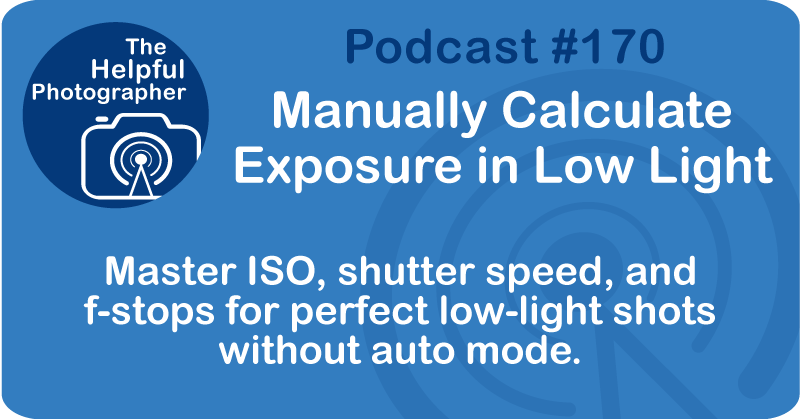Manually Calculate Exposure in Low Light #170

Today I'm talking about how to manually calculate exposure, especially when your camera can't do it for you. In photography, we often hear about the exposure triangle made up of ISO, aperture, and shutter speed. But there's actually a fourth element we don't talk about enough, and that's light itself. That's why I think of it more as a square than a triangle. When the light changes, you have to change at least one of the other settings in order to maintain a proper exposure.
Let's take a step back. Photographers measure light in units called stops. A stop is just a way of describing doubling or halving the light hitting your sensor. Here's what I'm talking about. If you go from ISO 100 to 200, you are getting one stop brighter, which means you've actually doubled the light. If you go from ISO 800 to 400, you're getting one stop darker and you've cut the light in half.
So every time you double or halve your ISO, you either double or halve the amount of light you're getting. Shutter speed works the same way. Going from one second to two seconds gives you one stop more light. Going in the other direction halves the light and the time. With aperture, things are a bit trickier because the numbers are based on ratios. But each standard aperture, like f2.8 to f4.0, is still one stop of light.
Another thing that you might note is in modern day cameras, we can usually move in 1/3 stop or 1/2 stop increments. You gotta check out your manual to see what your camera's doing. In other words, if your camera is moving in half stop increments, your dial has to click twice for one full stop. If your camera is moving in 1/3 stop increments, your dial has to click three times to move a full stop.
So here's a practical example. Let's say you're shooting at ISO 800 and two seconds. If you drop your ISO to 400, which is one stop less, you'll need to double your shutter speed to four seconds to keep the same exposure. Or if you go in the other way, bumping your ISO from 800 to 1600, you gain exposure and you'll need to cut your shutter speed in half to one second.
So why does this matter? Because most cameras can't calculate beyond 30 seconds. Although some Fujifilm cameras can go up to 60 seconds, most stop at 30. So if your light meter says you're underexposed at 30 seconds, you're gonna have to calculate it manually. Usually this happens when we're shooting under low light.
So here's an example on how to calculate your base exposure manually when you are in low light situations. One, open up your aperture as wide as it will go. Let's say that's f2.8. Set your ISO to 100, that's usually the lowest ISO most cameras can get to. Three, set your shutter speed to 30 seconds. Four, half press the shutter and look at your camera's light meter. If the meter shows overexposed, which is indicated by a plus sign or an arrow pointing to the positive side of the meter, reduce your shutter speed until it hits zero. If it shows underexposure, which is indicated by a negative sign or an arrow pointing to the negative side, increase your ISO until the meter reads zero.
Now, once you get to zero, you're done. That is your exposure. You're good to go. So the problem usually comes in not on the positive side, but on the negative side where you had to make up the exposure with ISO because we know that the higher the ISO, the lower your resolution. As I said earlier, every time you double your ISO, it's one stop brighter. You're gonna wanna keep track of how many stops you've adjusted because that will tell you how far off the original exposure was.
So why do you need to keep track of this? Well, let's say you're in this situation. You're at f2.8, which is wide open, and now your ISO is at 800, and your correct exposure time is 30 seconds, but you wanna shoot at ISO 100 because it gives you better resolution. That's three stops smaller and eight times amount of light. To keep the same exposure, you'll need to multiply your shutter speed by eight. That gives you a 240 second or four minute exposure time. The only way for you to get to the correct exposure time was to keep track of how many stops you moved your ISO.
Remember, your camera cannot calculate beyond 30 seconds. It should be noted that since most cameras can't shoot that long in regular mode, you'll need to switch to bulb or time mode and use a remote or a timer to get to that four minutes.
That's essentially it. Exposure is just a numbers game. Once you understand the stops, you can shoot in any lighting even when your camera gives up. Oh yeah, one more thing. Obviously, you're gonna need a tripod for this. I hope that was helpful. Until next time, keep on shooting.











